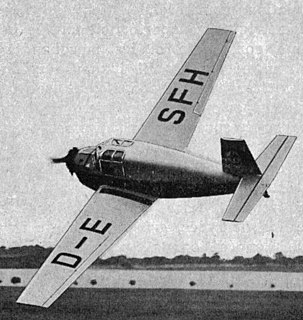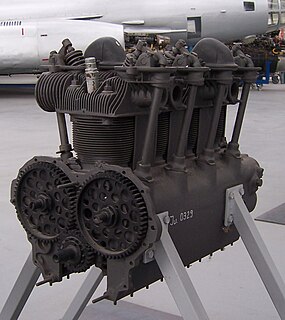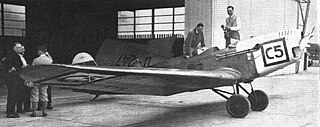Related Research Articles

The Fieseler Fi 5 was a single-engined two-seat sportplane of the 1930s. It was produced by the German aircraft manufacturer Fieseler Flugzeugbau, which was started by the World War I fighter ace and German aerobatic star, Gerhard Fieseler.

The Fieseler Fi 157 was an unsuccessful attempt at developing a radio-controlled, full-sized anti-aircraft target.

The Fieseler Fi 98 was a prototype ground-attack aircraft produced by German aircraft manufacturer Fieseler as a rival to the Henschel Hs 123.

The Klemm Kl 35 is a German sporting and training aeroplane developed as a successor to the Kl 25. A product of Klemm Leichtflugzeugbau Gmbh it shared the same single-engine, cantilever low-wing configuration as the earlier machine, the major difference being the introduction of an inverted gull wing.

PZL.26 was a Polish sports plane built in 1934 in the PZL works. Ordered by the Ministry of Defence, it was specifically designed for the upcoming Challenge 1934 International Touring Aircraft Contest.
The Hirth HM 506 was a six-cylinder air-cooled inverted inline engine that was developed from the earlier four-cylinder HM 504. The HM 506 was a popular engine for light aircraft of the 1930s to 1940s and powered the Bücker Bü 133A model trainer. The engine featured a cast magnesium alloy crankcase.

The Bölkow Bo 207 was a four-seat light aircraft built in West Germany in the early 1960s, a development of the Klemm Kl 107 built during World War II.

The Klemm Kl 107 was a two-seat light aircraft developed in Germany in 1940. It was a conventional low-wing cantilever monoplane of wooden construction with fixed tailwheel undercarriage. Wartime production totalled only five prototypes and some 20 production machines before the Klemm factory was destroyed by Allied bombing. Following World War II and the lifting of aviation restrictions on Germany, production recommenced in 1955 with a modernised version, the Kl 107B, of which Klemm built a small series before selling all rights to the design to Bölkow. This firm further revised the design and built it as the Kl 107C before using it as the basis for their own Bo 207.

The Bücker Bü 180 Student was a 1930s German two-seat sporting/training aircraft built by Bücker Flugzeugbau.

The Fieseler Fi 97 was a 1930s German four-seat cabin touring and competition monoplane aircraft designed and built by the German manufacturer Fieseler.

Klemm L 25, later Klemm Kl 25 was a successful German light leisure, sports and training monoplane aircraft, developed in 1928. More than 600 aircraft were built, and manufacturing licenses were sold to the United Kingdom and the United States.

The Klemm Kl 36 was a 1930s German four-seat cabin touring and competition monoplane designed and built by Klemm.
The Klemm Kl 31 was a touring aircraft, developed in Germany in the early 1930s. It was a conventional, low-wing cantilever monoplane with four seats in an enclosed cabin. The fixed, tailskid undercarriage had divided mainwheel units. The fuselage was built from welded steel tube, while the wings were wooden. Some Kl 31s saw service with the Luftwaffe as training and liaison aircraft.

The Klemm Kl 32 was a touring aircraft, developed in Germany in 1932, based on the Klemm Kl 31 as a competitor in the Challenge 1932 touring aircraft competition. Like its predecessor, it was a conventional, low-wing cantilever monoplane with fixed, tailskid undercarriage. The Kl 32, however, had a smaller cabin, and a fuselage built from wood rather than metal.

The Siebel Si.202 Hummel ("Bumble-bee") was a German light sportsplane of the late 1930s. It was an angular low-wing monoplane, which could be powered by a variety of small engines.

The Siebel Si 201 was a German air observation post and army cooperation aircraft, designed and built by Siebel. Evaluated against other types, the Si 201 did not enter production and only two prototypes were built.

The Fieseler Fi 253 Spatz,, was a light civilian aircraft, manufactured by the German company Fieseler in Nazi Germany. Only six units were produced, however, due to the Second World War.

The Gotha Go 150 was a light aircraft designed at the German company Gothaer Waggonfabrik in the late 1930s. It was intended for civilian use, but ended up being used as a military trainer.

The Zündapp 9–092 or Z 92 was a German four-cylinder, air-cooled, inline aero engine made by Zündapp and used in light aircraft of the late-1930s.

The Klemm L 26, later Klemm Kl 26, was a low-wing trainer aircraft built by Klemm.
References
- Notes
- Bibliography
- Nowarra, Heinz (1983). Die deutsche Luftrüstung 1933–1945. Bonn: Bernard and Graefe. pp. Teil 3, p.158–59.
- Taylor, Michael J. H. (1989). Jane's Encyclopedia of Aviation. London: Studio Editions. p. 561.
- World Aircraft Information Files. London: Bright Star Publishing. pp. File 899 Sheet 09.